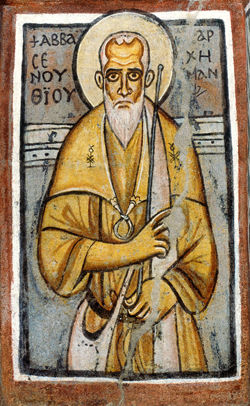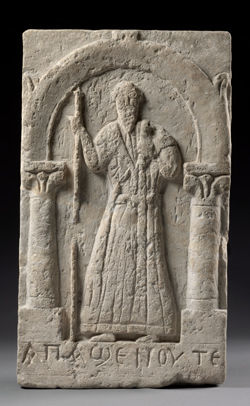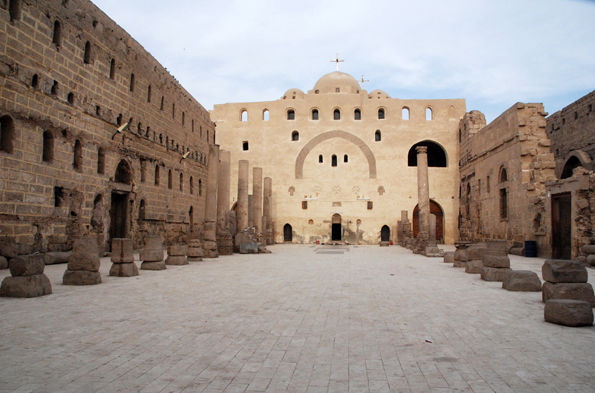
Left: Shenoute. Secco painting, ca. 7th century. North lobe of the sanctuary, Red Monastery Church, near Sohag, Egypt. Photograph: E. Bolman / © American Research Center in Egypt (ARCE); Right: Stele of Apa Shenoute. Egypt, 5th–6th century. Limestone. Stiftung Preußischer Kulturbesitz, Staatliche Museen zu Berlin—Skulpturensammlung und Museum für Byzantinische Kunst, Berlin (4475). © 2011 Antje Voigt-SMB-Museum für Byzantinische Kunst
Scholars have debated whether Saint Shenoute of Atripe lived from 332–451 or 350–466—an astonishing length of time in either case—but all agree that he was one of the most important monastic reformers the Coptic Church has ever known.
Shenoute, or Shenouda in Arabic, sought the monastic life during his youth. After his father's death, he joined the monastic settlement of his maternal uncle Saint Pigol, who was the founder of what is now called the White Monastery in Atripe, Sohag. Initially just a monk, Shenoute became headman of the monastery when his uncle died in 385, after which he developed the White Monastery's unique Cenobitic community tremendously, maintaining 2,200 monks and 1,800 nuns over a period of almost eighty-three years.
Following the path of his uncle, which was closely aligned with the ascetic beliefs of Saint Pachomios (ca. 290–346), Shenoute established strict monastic regulations within the walls of the White Monastery, exceeding the standards that had been followed by his predecessors. He demanded that the members of the community sign a pledge of absolute obedience, and he was willing to punish those who loosened the knot of monastic life.
View of the nave looking east, ca. 440 and later. White Monastery Church, near Sohag, Egypt. Photograph: E. Bolman
Shenoute abstained from paganism and heresies throughout his life. In 431, at the invitation of the Roman pope, Saint Shenoute and the Patriarch Cyril of Alexandria attended the First Council of Ephesus to voice opposition to the calling of the Holy Virgin Mary "Christokos" (Mother of Christ) rather than "Theotokos" (Mother of God) by Nestorius, the Patriarch of Constantinople. The divine nature of Christ was on the line.
As a scholar, Shenoute produced distinguished literary works for the Coptic Church written in Coptic and comprising 25,000 folios, 1,870 of which are extant. Shenoute's influential work led to his veneration as a saint, and to the honorary title of Father of the Coptic Church.
More than fifteen hundred years after Saint Shenoute's death, another important figure, Pope Shenuda III—the Egyptian Coptic Christian Pope of Alexandria and Patriarch of the See of Saint Mark—led the Coptic Church in Egypt for forty years until his recent passing on March 17, 2012, at the age of eighty-eight. His leadership benefited not only the Christian community but also Egypt as a whole by promoting peace and understanding. Pope Shenouda III was highly respected by all Egyptians, regardless of religion, and mourners paid their final respects last month at one of Egypt's oldest monasteries in Wadi al-Natrun.

